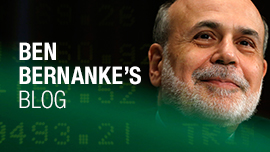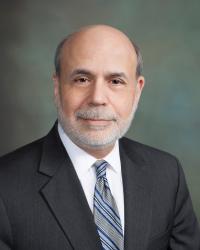Despite a long and sustained recovery from the Great Recession, a number of factors—including an aging population, slow productivity growth, and subdued inflation—continue to exert downward pressure on U.S. interest rates. It seems likely that even when monetary policy is at a neutral setting, neither restraining nor stimulating the economy, interest rates will remain significantly lower than in recent decades. One consequence of a low-rate environment is that monetary policymakers are more likely to find themselves constrained by the zero lower bound (ZLB) on nominal rates. Research by Fed economists Michael Kiley and John Roberts suggests that the ZLB could bind as much as 40 percent of the time in the future, limiting the scope for monetary easing and possibly imposing significant costs on the economy.
A number of scholars and policymakers have proposed ways the Fed might conduct monetary policy to reduce the costs associated with the ZLB. The basic idea motivating many of these strategies is that promises by the central bank to keep rates ‘lower for longer’ can help reduce longer-term rates and encourage spending today, even when further cuts in the short-term interest rate are not feasible. In a previous blog post and paper, I proposed one variation of this kind of commitment, called “temporary price-level targeting” (TPLT). In brief, under TPLT, following adverse shocks to the economy that force short-term rates to zero, the Fed would commit in advance to avoid raising rates at least until any shortfalls of inflation from target during the ZLB period had been fully offset. So for example, if the Fed has a 2 percent inflation target in normal times, under TPLT it would commit not to begin raising rates from zero until average inflation since the beginning of the ZLB period was at least 2 percent. (Once rates have lifted from zero, policy is guided by a conventional rule such as a Taylor rule.) Since inflation early in the ZLB period would likely be below 2 percent, meeting this condition would typically involve some overshoot of the inflation target before rates were raised. Some willingness to accept temporary overshoots of the inflation target is typical of lower-for-longer strategies.
So what could go wrong? A potential issue with lower-for-longer policies, including TPLT, relates to their credibility with the public. To an important extent, these policies work by affecting the public’s expectations about the future course of policy and the economy. For example, in theory, committing to keeping rates lower for longer should encourage extra spending today both by reducing expectations of future short-term interest rates (which in turn should lead to lower current longer-term rates) and by raising expected future inflation. But in practice, people may not understand or believe the Fed’s promises about its future behavior, that is, its promises may not be credible. That lack of credibility could cause lower-for-longer policies to work less effectively than advertised.
Interestingly, imperfect credibility could even lead lower-for-longer policies to be counterproductive. For example, in a comment on my original TPLT proposal, Fed governor Lael Brainard raised a particular risk of such policies, which I’ll call the overshooting problem. As just noted, lower-for-longer policies typically involve overshoots of inflation at the end of the ZLB period. If people understand that these overshoots are intended to be temporary, and behave accordingly, then a brief period of higher inflation should impose few costs. However, if people don’t understand or believe the Fed’s strategy—if the Fed is imperfectly credible—and their expectations of inflation become un-anchored as inflation rises above target, then inflation could be more persistent and the costs of the policy could be much higher than anticipated.
In a recent paper, Kiley, Roberts, and I studied TPLT and other lower-for-longer policies, using simulations of the Fed’s principal economic model, FRB/US. To assess the importance of Fed credibility for the performance of alternative policies, we made two alternative assumptions about expectations. In some simulations, we assumed that the Fed is fully credible, in that everyone in the economy—households, businesses, and financial market participants—understands and believes the announced monetary policy framework. This assumption might be reasonable if the economy and policy have been stable for a while, giving people time to get used to a pattern of Fed behavior, but less so if the policy framework has recently undergone a significant change. Under our alternative assumption, the Fed’s policy framework is only partially credible. In this case, we continued to assume that participants in financial markets understand and believe the Fed’s policy framework—they have strong incentives to do so—implying that key financial variables like long-term interest rates, stock prices, and the exchange rate respond to Fed announcements. However, in this scenario households and firms are assumed to ignore the Fed and form their expectations about inflation, income, and other variables based on the past behavior of the economy. These alternative assumptions allowed us to evaluate the extent to which the benefits of lower-for-longer policies depend on strong assumptions about the credibility of Fed announcements.
To jump to the punchline, our paper finds that, even taking into account the possibility of imperfect credibility of the Fed’s framework, most of the lower-for-longer policies we analyze deliver better outcomes than traditional policy approaches in low-interest-rate environments, although naturally some do better than others. Although the inability to influence the expectations of households and businesses handicaps lower-for-longer policies somewhat, so long as financial markets respond appropriately, these policies retain the basic advantage of being able to augment stimulus even when short rates are at zero. In the remainder of this post I’ll illustrate a few of these points for the case of TPLT. For the analyses of other strategies, please see the paper.
TPLT and the overshooting problem
In the paper, as mentioned, we used the Fed’s large-scale macro model known as FRB/US to compare alternative policy strategies. We ran model simulations to study how different strategies perform over time given a mix of shocks to the economy similar to those seen historically. We also used FRB/US to simulate a specific scenario in which a large shock to consumer spending forces the economy into a deep recession, during which the ZLB binds. Importantly, we assumed in all our simulations that the long-run equilibrium nominal interest rate is 3 percent, well below its historical average but in line with recent estimates. We compared lower-for-longer policies like TPLT against Taylor rules, taken to be representative of traditional approaches.[1]
The chart below, which is based on the severe-recession scenario, illustrates both the benefits of TPLT, relative to a Taylor rule, and also what I have called the overshooting problem.[2] The lines show the simulated behavior of inflation during and after the recession under each of the two approaches. (The horizontal axis is in quarters, and the economy is assumed to hit the ZLB in quarter 0. Here and below, the inflation target is assumed to be 2 percent.) Importantly, the scenario on which the figure is based also assumes partial credibility of the Fed, that is, asset prices (including long-term interest rates) are set taking account of the policy framework but the expectations of households and businesses are not.
Behavior of Inflation in a ZLB Episode under Alternative Policies and with Partial Credibility

The shortcoming of the Taylor rule in this scenario is evident from the figure: because of the constraint imposed by the ZLB, it doesn’t provide enough stimulus in response to the recessionary shock. Inflation falls well below target and remains about 1 percent too low more or less indefinitely. Output and employment (not shown) perform poorly as well in this scenario under the Taylor rule, with output remaining well below potential for an extended period. Similar results obtain, by the way, when this conventional policy is assumed to be fully credible.
In contrast, under TPLT, inflation returns to target much more quickly after the recessionary shock, reflecting the greater stimulus at the ZLB provided by this approach—and, not surprisingly, inflation even overshoots its target, as TPLT typically requires. What happens then? It is at this point that the expectational assumption comes into play. If the public fully understood the TPLT strategy, including that the inflation overshoot is intended to be temporary, then their inflation expectations would remain well-anchored at the 2 percent target, which in turn would help ensure a quick return of inflation back down to 2 percent. However, we are assuming only partial credibility here. Under that assumption, households and businesses, not being well attuned to the Fed’s plans and instead extrapolating recent experience, infer from the bout of higher inflation that inflation will remain above target. This unanchoring of inflation expectations becomes self-fulfilling, with other macro variables like GDP and employment (not shown) overshooting as well. This relatively poor outcome illustrates Governor Brainard’s critique of TPLT.[3]
Can the TPLT framework be calibrated to avoid the overshooting problem while retaining its other benefits? In the paper, Kiley, Roberts, and I also considered a less accommodative version of TPLT in which the Fed commits only to make up shortfalls of inflation of the past year, rather than since the beginning of the ZLB period.[4] In most cases, this shorter “lookback” period implies keeping rates at zero for a shorter time than in the original TPLT framework. As the figure below shows, the TPLT rule with a one-year lookback (the center line) gets inflation back to target more quickly than the Taylor rule, but more slowly than the original TPLT rule, as intuition would suggest. Critically, however, TPLT with a one-year lookback avoids the overshoot that occurs under original TPLT, keeping inflation close to target in the long-run, even under the assumption of partial credibility. By limiting the initial overshoot in inflation, this modified policy also avoids destabilizing inflation expectations.
Behavior of Inflation in ZLB Episode under Alternative Policies and with Partial Credibility

The results of our paper suggest that the lesson of these figures generalizes: Lower-for-longer policies do tend to generate temporary increases in inflation upon exit from the ZLB, which become more costly if (because of partial credibility or other reasons) there is a risk that inflation expectations become unanchored. However, this risk can be mitigated by scaling back how much accommodation is provided toward the end of the ZLB period.
Overall performance of TPLT
Considering the severe recession scenario is useful, but that scenario is not representative of the ups and downs of the economy over a long period. The main results of our paper relied on hundreds of simulations of FRB/US, in which the economy is assumed to be hit with shocks typical of the period 1970-2015. These simulations provide another metric for comparing lower-for-longer policies, like TPLT, and more traditional approaches. As an illustration, the two figures below show how inflation and output fare on average under the two alternative expectational assumptions when the Fed follows a Taylor rule and when it follows TPLT with a one-year lookback.
Average Inflation and Output Gaps under Alternative Policies


As shown in the figures, under the Taylor rule, inflation averages well below the Fed’s 2 percent target under both expectational assumptions, while the output gap is negative (actual output is below potential) on average. This confirms yet again the finding that conventional monetary frameworks deliver insufficient stimulus, on average, when the neutral nominal interest rate is low and the ZLB often constrains policy. Moreover, the finding of inadequate stimulus is evident under either full or partial credibility. In contrast, temporary price-level targeting with a one-year lookback period keeps inflation close to the Fed’s 2 percent target under both expectational scenarios, and it also keeps the output gap slightly positive on average.
Policies should be evaluated based not only on average outcomes, but on the amount of volatility they induce in the economy. The figures below show the volatility of inflation and the output gap in our simulations, for both policy rules and both expectational assumptions. We find that TPLT with a one-year lookback delivers lower volatility of both inflation and output, under both full and partial credibility.
Volatility of Inflation and Output Gaps under Alternative Policies


In sum, the figures suggest, and our paper confirms in more detail, that lower-for-longer strategies, like TPLT, can work even if the Fed’s commitment is not fully credible outside financial markets. Affecting financial-market expectations is enough to get extra stimulus at a time when it is greatly needed, even if households and businesses do not pay attention to Fed announcements. However, the possibility that a period of higher inflation could lead to an un-anchoring of inflation expectations by households and businesses implies that lower-for-longer policies must be carefully calibrated to avoid excessive overshoots of inflation at the exit from the ZLB. In the case of TPLT, shortening the inflation lookback period appears to achieve an appropriate balance of avoiding inflation overshoot while still benefiting from additional stimulus during the time when the economy is at the ZLB.
*Michael Ng and Sage Belz contributed to this post.
[1] In this post the “Taylor rule” refers to an inertial Taylor rule, in which the interest rate is set according to
![]() where i is the nominal interest rate, r* is the long-run real equilibrium rate of interest, π is core PCE inflation, π* is 2% and ŷ is the output gap. ρ is set to 0.85. This version of the Taylor rule has been shown to have stabilizing properties. Our simulations ignore the possibility that monetary policymakers could employ quantitative easing, negative interest rates, or other unconventional approaches. [2] All figures in this post are based on Bernanke-Kiley-Roberts (2019).[3] With partial credibility, some of the inflation overshoot shown in the figure is actually desirable, since it helps to return to target the public’s inflation expectations, which may have dipped during the recession. However, as discussed in the text, too large an overshoot risks un-anchoring those expectations to the upside.[4] This is essentially an inflation threshold policy, in which the Fed promises not to raise rates from zero until a certain inflation condition is met. During the recovery from the Great Recession, the Federal Open Market Committee adopted forward guidance which made both attaining the inflation target and reaching a stipulated level of unemployment a necessary condition for raising rates.
where i is the nominal interest rate, r* is the long-run real equilibrium rate of interest, π is core PCE inflation, π* is 2% and ŷ is the output gap. ρ is set to 0.85. This version of the Taylor rule has been shown to have stabilizing properties. Our simulations ignore the possibility that monetary policymakers could employ quantitative easing, negative interest rates, or other unconventional approaches. [2] All figures in this post are based on Bernanke-Kiley-Roberts (2019).[3] With partial credibility, some of the inflation overshoot shown in the figure is actually desirable, since it helps to return to target the public’s inflation expectations, which may have dipped during the recession. However, as discussed in the text, too large an overshoot risks un-anchoring those expectations to the upside.[4] This is essentially an inflation threshold policy, in which the Fed promises not to raise rates from zero until a certain inflation condition is met. During the recovery from the Great Recession, the Federal Open Market Committee adopted forward guidance which made both attaining the inflation target and reaching a stipulated level of unemployment a necessary condition for raising rates.
The Brookings Institution is committed to quality, independence, and impact.
We are supported by a diverse array of funders. In line with our values and policies, each Brookings publication represents the sole views of its author(s).







Commentary
Evaluating lower-for-longer policies: Temporary price-level targeting
February 21, 2019